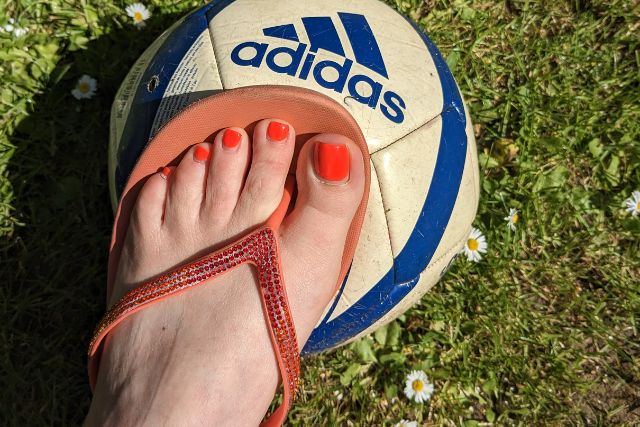
Ah, the beloved flip flops – the go-to summer footwear that exudes comfort, convenience, and a carefree vibe.
They are a staple in many people’s wardrobes, offering an easy slip-on design and an open, airy feel. While flip-flops may seem like the perfect footwear choice for warmer days, it’s important to understand that they may not be as beneficial for your feet as you might think.
Let’s first explore the potential drawbacks of wearing flip-flops:
- Lack of arch support:
One of the key issues with flip-flops is their lack of proper arch support. Unlike trainers or shoes with contoured insoles, flip flops usually have flat, thin soles that fail to provide adequate support to the natural arch of your foot. This can lead to overpronation (excessive inward rolling of the foot) or supination (excessive outward rolling of the foot), both of which can result in discomfort, foot fatigue, and even conditions such as plantar fasciitis.
- Minimal cushioning and shock absorption:
Another downside of flip-flops is their minimal cushioning and shock absorption capabilities. Most flip-flops have thin, often hard soles. This lack of cushioning can place excessive stress on your joints, including the ankles, knees, and hips, as they do not effectively absorb the shock generated with each step. Prolonged walking or standing in flip-flops can contribute to joint pain, especially if you have existing conditions like arthritis.
- Increased risk of injuries:
Flip flops, with their open-toed design and loose fit, leave your feet more vulnerable to injuries. Due to their minimal foot coverage, they offer little protection from sharp objects, falling debris, or accidental stubbing. Additionally, the lack of stability and secure straps can cause you to trip or stumble, leading to ankle sprains, fractures, or other foot-related mishaps. Flip flops are not suitable for activities that require stability, such as running or hiking, as they increase the risk of accidents.
- Changes in gait and posture:
Wearing flip-flops alters your natural gait and posture. To keep flip flops on your feet, you tend to scrunch and grip with your toes and use shorter strides, which can affect the biomechanics of your lower limbs. Over time, this can lead to muscle imbalances, strain on tendons and ligaments, and even issues in the lower back. The lack of ankle stability in flip-flops can also force your leg muscles to work harder, which can result in fatigue and discomfort.
So what can you do it you’re just a die-hard flip-flop lover?
While flip-flops may not be the most ideal footwear for maintaining foot health, there are ways to enjoy them without causing significant harm. With a few mindful practices, you can mitigate some of the potential drawbacks associated with flip-flop wear.
Here are our tips and tricks to help you wear flip-flops while prioritizing your foot health.
- Choose supportive flip-flops:
Opt for those that offer better support and cushioning. Look for models with contoured footbeds, arch support, and ample cushioning. Choose flip-flops made from high-quality materials that provide better shock absorption and stability. While these options may be pricier, they can significantly enhance your comfort and minimize the negative impact on your foot health. We recommend companies like Fit Flop, Skechers, and Archies, who are all strides ahead in the flip-flop game!
- Limit your wearing time:
To minimize the potential risks, it’s important to limit the amount of time you spend wearing flip-flops. Reserve them for short periods and avoid wearing them for long walks or extended periods of standing. Keep them for things like the beach or around the pool.
- Alternate footwear:
Give your feet a break from flip-flops by alternating them with more supportive footwear options. This will allow your feet and leg muscles to rest and recover from the strain caused by flip-flops. Go barefoot when you can and allow your foot to get its proper mobility. Alternating footwear will help maintain a more balanced gait and reduce the risk of foot-related issues.
- Be mindful of your walking style:
When wearing flip-flops, pay attention to your walking style. Avoid gripping the flip-flops with your toes. Allow your feet to move naturally and maintain a relaxed gait. This will help reduce muscle imbalances and prevent strain on your tendons and ligaments. Look out for the companies that offer a tighter and more flexible post between your toes, as this helps you not to over-grip.
- Avoid rigorous activities:
It’s essential to avoid engaging in rigorous activities while wearing flip-flops. Activities such as running, hiking, or playing sports require more stability and support than flip-flops can provide. Opt for athletic shoes or footwear specifically designed for such activities to reduce the risk of injuries and protect your feet.
- A bit of TLC:
Flip flops expose your feet to the elements, so it’s important to keep them clean and dry. Moisture can lead to fungal infections such as athlete’s foot. Ensure that you thoroughly clean and dry your feet, especially the areas between your toes, before putting on flip-flops. Consider using antifungal powders or sprays to minimize the risk of infections.
7. Do your feet exercises. Our feet are so important. They act as weight distribution for the whole body, they help with mobility and propulsion. So we need our feet and toes to stay mobile and strong. Thankfully Mr. Joe Pilates cleverly realised the importance of our feet and developed exercises to help you with your aches, improve toe dexterity, help with bunions and hammer toes, and generally improve the strength and stretch of the feet. Discover the Toe Corrector and the Foot Corrector in a 1:1 session to help you with your foot health.
